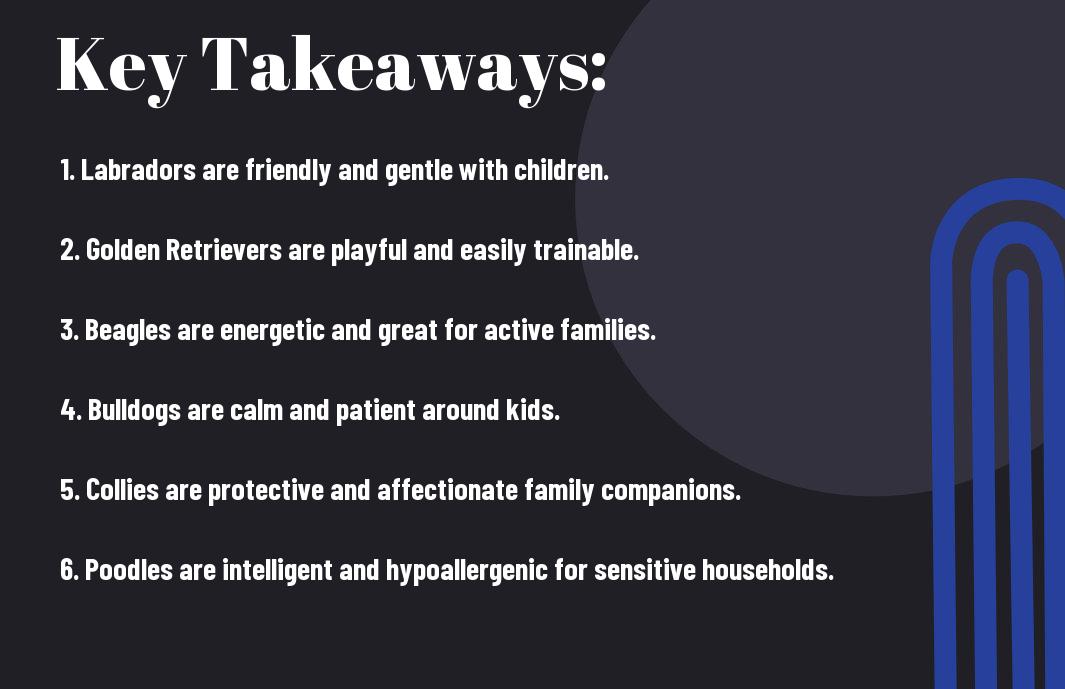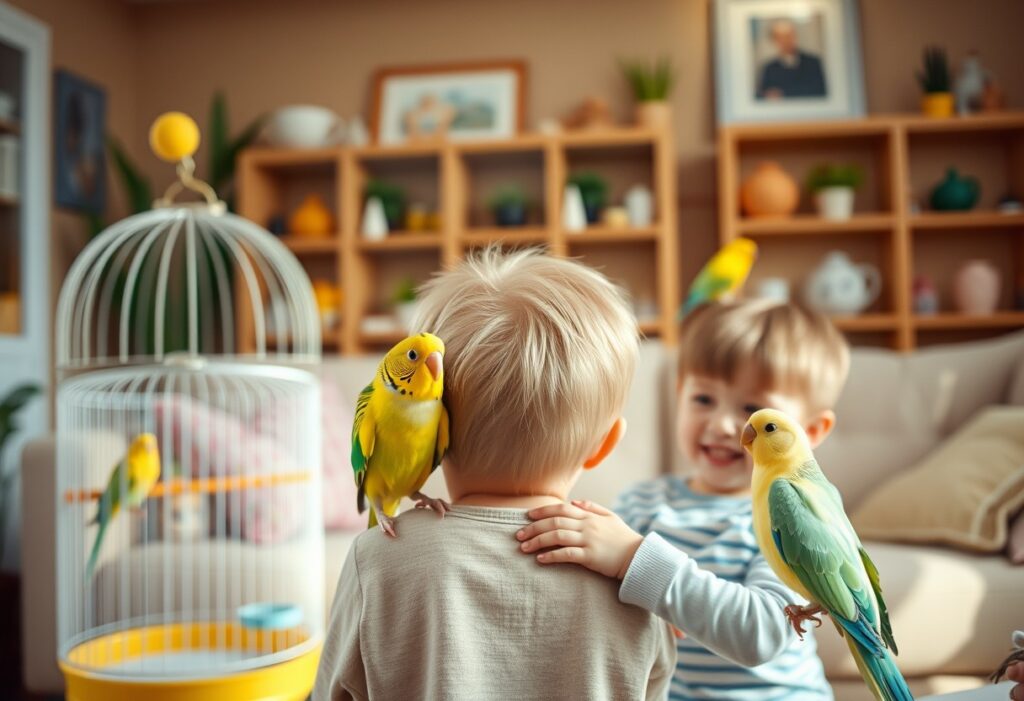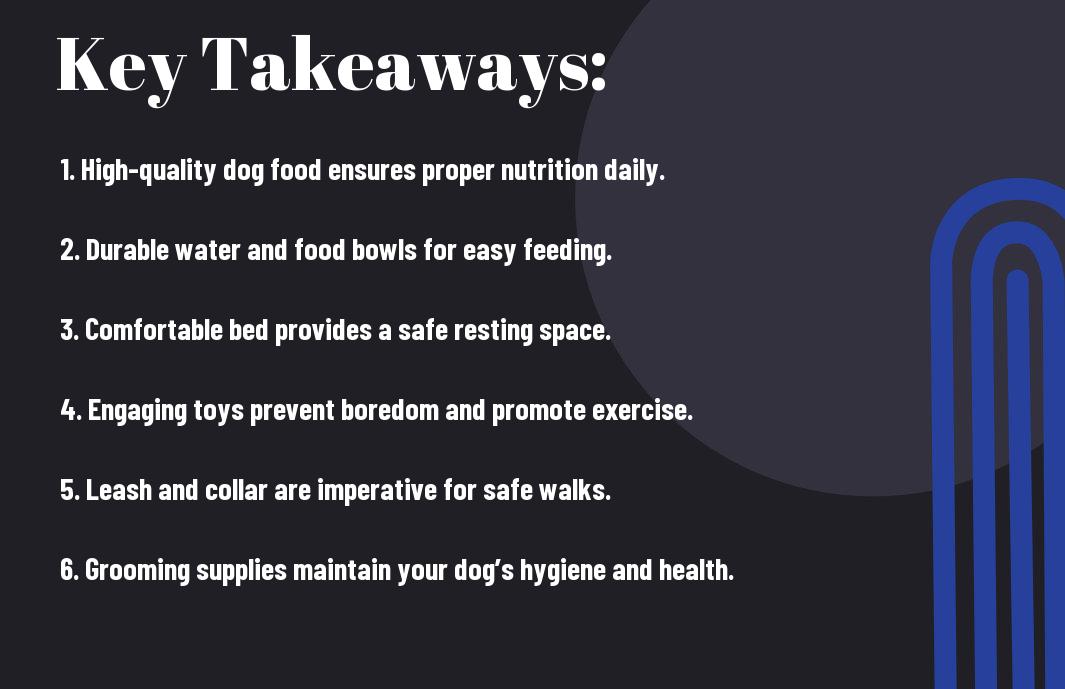It’s necessary to choose the right dog breed for your family if you have kids. The ideal furry companion should be patient, gentle, and energetic to keep up with your little ones. Certain breeds are known for their friendly demeanor and ability to bond with children, making them perfect family pets. In this blog post, you’ll discover the top dog breeds that not only ensure endless fun but also promote a nurturing environment for your kids. Let’s explore the characteristics that make these breeds exceptional family members!


Understanding Family Dynamics
A family’s dynamics play a significant role in determining the best dog breed for your household. Each family is unique, and your specific circumstances, values, and lifestyle choices will influence how well a dog will integrate into your home. Understanding your family’s structure, including the ages of your children, their activity levels, and any special needs they may have, is imperative when selecting a dog. The right canine companion should complement your everyday life, enhancing the overall atmosphere and contributing to a balanced family environment.
Assessing Your Family’s Lifestyle
After evaluating your family’s routines and commitments, you can begin to identify the type of dog that best fits your home. Consider how much time your family spends at home versus out, as well as your activity levels. Do you participate in active outdoor activities, or are you more inclined to have quiet, indoor family time? The dog’s breed should align with these aspects of your lifestyle to ensure a harmonious relationship between your children and the pet.
Also, assess how much time your family can dedicate to caring for a dog. If you have busy schedules, a breed that is adaptable and self-sufficient may be a better fit. On the other hand, if you have ample time and energy to invest, you might choose a breed that requires more interaction and training. It’s important to choose a dog that can thrive in your environment, providing joy without adding undue stress.
The Role of a Dog in Family Life
Between teaching responsibility and providing companionship, a dog can dramatically shape your family dynamics. Dogs can serve as protective guardians, loyal friends, and sources of motivation for physical activity. They foster empathy and teach kids valuable life skills, such as patience, kindness, and respect for living beings. The presence of a dog often leads to increased playtime and social interaction within the family, ultimately enhancing bonds among family members.
Hence, selecting the right dog breed also involves understanding the potential roles your canine companion will play in family life. A dog can be a source of endless joy, but it can also pose challenges, especially if the temperament mismatches your family’s needs. Opting for a breed known for its gentle disposition and friendly nature is vital when you have children at home. Such breeds are more likely to adapt well to the chaos of family life, love to partake in all family activities, and foster a positive, loving environment. Prioritize finding a breed that will not only fit into your family’s lifestyle but also thrive in it, ensuring a harmonious and fulfilling relationship for years to come.
Characteristics of Family-Friendly Dog Breeds
There’s a lot to consider when choosing a dog breed that suits your family, especially when you have kids. The ideal family dog should possess specific characteristics that ensure safety, compatibility, and overall happiness within the home. Various attributes such as temperament, size, energy levels, and trainability play a significant role in ensuring that your new furry friend integrates well with your family’s lifestyle.
Temperament
Temperament is one of the key factors to consider when selecting a family-friendly dog breed. You’ll want a dog that is known for its gentleness and affectionate nature. Breeds such as Golden Retrievers and Labradors are often noted for their friendly dispositions and tolerance of children, making them perfect companions for your little ones. Look for dogs that exhibit a calm demeanor, without excessive fearfulness or aggression.
Moreover, dogs that showcase a playful yet composed temperament are often ideal for families. You’ll want a breed that can enjoy active playtime but also knows when to settle down. Breeds with a stable temperament are more likely to create a harmonious environment, allowing you to confidently let your kids play and interact with their furry sibling.
Size Considerations
About size, it’s vital to think about both the dog’s physical dimensions and how that will affect your children. Large breeds have a different set of needs and may unintentionally knock over a child during play. On the other hand, small breeds may be more susceptible to injury during roughhousing. Finding a balanced size that suits your family’s lifestyle is vital.
This consideration ensures you pick a breed that aligns with your home and daily routine. A medium-sized dog can often be the perfect fit, providing enough heft to handle children’s antics while also being manageable during walks or outings. Ultimately, it’s about weighing the pros and cons of size in relation to your specific family dynamics.
Energy Levels
For families with young kids, understanding a dog’s energy levels is critical. You may find that a breed with a medium to high energy level can match the enthusiasm of your children during playtime. Breeds like Beagles or Boxers are typically known for their playfulness and ability to keep up with kids, providing endless fun and activity within your household.
With enough physical and mental stimulation, a high-energy dog can thrive in a bustling family environment. It’s important to ensure that your kids are also involved in the daily exercise routines of your dog, as this will help build a stronger bond between them.
Trainability
Trainability is another significant attribute to consider when choosing a family-friendly dog breed. Dogs that are eager to please, like Collies or Poodles, often respond well to commands and training sessions, making them easier for you to teach vital household rules. A well-trained dog is less likely to engage in unwanted behaviors, creating a safer and more enjoyable environment for your children.
Considering a dog’s trainability can save you from potential challenges, especially with young kids underfoot. Positive reinforcement techniques often work wonders, allowing you to cultivate a trusting relationship and ensuring that your dog understands how to interact appropriately with your family.
Top Dog Breeds for Families with Kids
Labrador Retriever
For families with kids, the Labrador Retriever is often the go-to breed due to its incredible temperament and playful nature. These dogs are known for their friendly disposition and gentle behavior, making them a fantastic choice for households with children. Labradors love to be part of family activities, whether it’s a fun day at the park or a cozy evening at home. Their loyalty and protective instincts further ensure that they will keep a watchful eye on your kids, providing peace of mind to parents.
Around this breed, you will find an abundance of energy. Labradors thrive on physical activity and enjoy engaging playtime with children, making them the perfect companion for your active lifestyle. When introducing a Labrador into your family, be prepared for plenty of affection, companionship, and fun-loving antics that will keep your kids entertained for hours on end.
Golden Retriever
Before considering which dog breeds are suitable for families, the Golden Retriever should be at the top of your list. These dogs are renowned for their friendly, tolerant attitude and make excellent family pets. Their eagerness to please and trainable nature allows them to adapt easily to family life, ensuring that they become an integral part of your household. Also, with their love for children, these dogs can foster a strong bond and provide companionship for your little ones.
In fact, Golden Retrievers have a sweet demeanor that makes them great at handling the chaos that young kids can bring. They are highly social animals and thrive on interaction with family members, making them exceptionally well-suited for households that include children.
Beagle
For a family seeking a smaller yet spirited dog, the Beagle is an excellent choice. These affectionate pups are known for their friendly disposition and playful energy, making them wonderfully interactive companions for kids. Beagles are curious creatures, and their playful antics often lead to laughs and joy, fostering an engaging environment for your children. With their inherent love for being part of family activities, Beagles help promote a strong family bond.
Further, Beagles are known for their great endurance, so whether you’re off for a quick play session at the park or going for a longer hike, they’ll keep pace with your family adventures. Their social nature encourages your kids to be active while learning responsibility in caring for their pet.
Bulldog
One of the most recognizable breeds, the Bulldog, is an ideal companion for families with children thanks to their calm and loving nature. These dogs are gentle souls that tend to be very patient with kids, making them a great choice for families. Bulldogs have a strong, sturdy build and a calm demeanor, which adds to their charm as family pets. They are also relatively low-energy, making them suitable for families who may not have a lot of extra time for daily exercise.
Bulldog breeds definitely offer a great mix of gentle companionship and loyalty that kids can rely on. They often develop strong bonds with their family and can make for a lively playmate for children while providing a comforting presence in the home.
Poodle
Bulldog lovers may be surprised to learn that Poodles are among the best family dogs as well. Poodles come in various sizes—standard, miniature, and toy—allowing families to choose one that best suits their lifestyle. Known for their high intelligence, Poodles are highly trainable and adaptable to a variety of situations, making them fantastic companions for kids. Their playful nature and love for activity mean they enjoy games and playtime just as much as any child.
For instance, Poodles are known for their hypoallergenic coats, making them suitable for families with allergy concerns. Their affectionate, friendly demeanor means they easily fit into a family dynamic and create lasting memories with your children.
Boxer
Poodle enthusiasts should also consider Boxers when looking for a family-friendly dog. These dogs are energetic, playful, and exceptionally loyal to their families, making them perfect companions for children. Boxers are known for their silly antics which entertain children, ensuring that playtime is always exciting. Their boundless energy requires active families, so if you have kids who love to run and play, a Boxer will match their enthusiasm every step of the way.
Due to their strong protective instincts, Boxers can also serve as guardians for your children, providing a reassuring presence. This breed can offer a remarkable balance of energy and nurturing love that every family needs.
Cavalier King Charles Spaniel
Between their endearing appearance and gentle temperament, the Cavalier King Charles Spaniel proves to be an excellent addition to any family. These dogs are known for their affectionate nature and willingness to cuddle, making them great companions for kids of all ages. They thrive on attention and are happiest when they are a part of family activities, whether that be snuggling on the couch or joining in on playtime outside.
A Cavalier King Charles Spaniel’s adaptable size and friendly demeanor make them particularly well-suited for families living in various environments, including apartments or larger homes. They love to interact, promoting emotional bonds with children that last a lifetime.

Evaluating Breed-Specific Traits
Keep in mind that not all dog breeds are created equal, especially when it comes to their adaptability to different home environments. Selecting a breed that meshes well with your living space, lifestyle, and family dynamics is vital for establishing a harmonious relationship. Each breed has its own set of requirements and traits, which can impact how well they adjust to your home. For example, some breeds thrive in larger spaces and may need room to roam and play, while others can be perfectly content in smaller, more confined areas, like apartments.
Adaptability to Home Environment
Across various breeds, you will find a wide range of adaptability traits that make certain dogs more suitable for family living. Breeds such as the Labrador Retriever and the Beagle are known for their amiable natures and ability to adapt to both busy households and quieter environments. In contrast, some breeds may display a stronger need for specific conditions, requiring either ample space to run around or a more predictable routine to feel secure. Evaluating these factors will help you choose a dog that complements your home dynamics.
Grooming Needs
On the other hand, grooming needs can vary significantly from breed to breed, impacting your choice if time and maintenance are a concern. For example, breeds like the Poodle and the Cocker Spaniel require regular grooming and maintenance to keep their coats tangle-free and healthy. Conversely, short-haired breeds such as the Boston Terrier or Beagle generally require less frequent grooming and are often easier to care for, making them more suitable for busy families.
Consequently, it’s vital to weigh the grooming requirements of each breed against your lifestyle and availability. You might love the look of a fluffy dog, but if that breed requires extensive grooming a few times a month, this commitment may not fit within your timeframe. Ensuring that your new dog fits into your grooming routine will help both you and your pet enjoy a cleaner, more comfortable living environment.
Health Considerations
After evaluating adaptability and grooming needs, it’s important to consider the health considerations associated with specific breeds. Some breeds are genetically predisposed to certain health issues, which can lead to higher vet bills or a decreased quality of life for your dog. Breeds like the Bulldog and Dachshund are known for having specific health problems, while others, such as the Boxer and Golden Retriever, may face different challenges. Understanding these health considerations can aid you in making an informed choice about which breed is right for your family.
For instance, researching the breed’s common health issues can be invaluable in your decision-making process. If you opt for a breed prone to hip dysplasia or respiratory issues, you’ll want to be prepared to address these problems with regular veterinary check-ups and potential emergency care. Choosing a breed with fewer known health issues may lower long-term costs and enhance your overall experience as a dog owner.
Training and Socialization
Unlike many misconceptions, training and socialization are not just additional tasks for dog owners; they are necessary elements for fostering a harmonious relationship between your dog and your family. A well-trained dog is more confident, better equipped to handle new situations, and is often more enjoyable to be around. This is particularly important when you have children, as it ensures that your dog can behave appropriately in the presence of young family members, making your home a safer and more welcoming space.
Importance of Early Training
On average, the early weeks of your dog’s life are foundational in shaping their behavior and temperament. Introducing your puppy to basic commands and house training as soon as you bring them home can set the tone for their development. Early training helps to establish boundaries and teaches your dog what is acceptable behavior within the family. This not only helps with obedience but can also reduce the likelihood of problematic behaviors that can arise if a dog is not properly trained.
Additionally, early training can strengthen the bond between you and your dog. The more time you spend training and communicating with your puppy, the more they understand you, leading to a mutually respectful relationship. This connection is particularly important in households with children, as it allows your dog to be more attuned to their actions and needs.
Socialization Techniques
Among the various aspects of dog training, socialization is one of the most important components. Socialization involves exposing your dog to different environments, people, and other animals to help them develop a well-rounded temperament. By introducing your dog to a variety of experiences from a young age, you’ll be equipping them with the skills they need to respond calmly and confidently to new encounters, such as family gatherings or children’s playdates.
In fact, the more experiences you can provide for your dog, the more adaptable they will become. Consider taking your pup to local parks, puppy classes, or even pet-friendly events. These opportunities not only help your dog become comfortable in diverse environments but also promote positive interactions with strangers and other dogs. This exposure can significantly diminish anxiety and fear, enabling your dog to integrate more smoothly into the family dynamic.
Engaging Kids in Training
Around your home, involving your children in the training process can be highly beneficial for both your dog and your kids. Making training a family activity teaches your children responsibility and empathy toward animals, all while ensuring that your dog learns important commands and social skills. Simple tasks like feeding, walking, or practicing sit and stay commands can be great ways for kids to bond with your dog while reinforcing good behavior.
Kids can also play a valuable role in providing consistent positive reinforcement. By encouraging them to praise your dog whenever they perform a desired behavior, you instill a sense of teamwork and accountability in your children. This interaction not only boosts your dog’s confidence but can also enrich your kids’ experience of having a pet in the home.
Kids who actively participate in training sessions are more likely to develop a deep bond with your dog. Engaging in this mutual learning experience allows your children to appreciate the effort behind training, creating a more respectful relationship that can positively influence both your dog’s behavior and your kids’ attitudes towards responsibility.
Maintaining Safety and Well-Being
Now, ensuring the safety and well-being of both your dog and your children is imperative for fostering a harmonious household. This involves teaching your kids how to interact with dogs in a respectful and understanding manner. When your child knows how to approach and interact with your furry family member, it not only helps build a positive relationship but also minimizes the risk of accidents or misunderstandings.
Teaching Kids How to Interact with Dogs
Beside encouraging gentle behavior, it’s vital to instruct your children about the proper ways to approach dogs. They should understand that dogs can be sensitive to movements and sounds, so abrupt actions could startle them. Emphasize the importance of asking permission before petting a dog, especially if it’s not their own. Teaching your child to extend their hand slowly for the dog to sniff first can help the two create a comfortable introduction.
Additionally, it’s imperative to highlight the importance of respecting the dog’s space, particularly when it is eating or sleeping. Instruct your kids to avoid hugging or cornering the dog, as this can be intimidating for many canine companions. By instilling these guidelines, you’ll be fostering a mutual respect between your children and your dog that leads to a safer environment.
Recognizing Dog Cues
Across various breeds, dogs communicate their feelings through body language and vocalizations. It’s important for you and your children to learn how to recognize these cues to prevent any unwanted interactions. For example, a dog that is wagging its tail may appear friendly, while a dog that is growling or has its ears pinned back could indicate discomfort or aggression. Teaching your children to pay attention to these signals can help them act accordingly and respect the dog’s boundaries.
Due to the diversity in dog personalities, understanding your dog’s unique cues becomes even more vital. Some dogs may be more tolerant of children and their exuberance, while others might prefer quieter interactions. Encourage your kids to take note of their dog’s reactions and use that information to guide their playtime. This understanding will not only keep your children safe but will also enhance the bond between them and your dog.
Creating a Safe Environment for Play
Between the excitement of playtime and the natural curiosity of children, creating a safe space for interactions is key. Make sure to design a play area where your kids can interact with the dog safely, free from hazards such as sharp objects or tiny toys that could be swallowed. Establishing clear boundaries within your home can also help in maintaining order during playtime.
For instance, setting up a designated dog area can provide your canine companion with a space where it feels secure and can retreat if things get overwhelming. Teaching your kids to respect this space will ensure your dog has the choice to engage or take a break. A structured environment where your dog knows they can feel safe will ultimately lead to more enjoyable playdates for everyone involved.
To wrap up
From above, you can see that selecting the best dog breed for your family with kids involves a careful consideration of temperament, energy levels, and compatibility. Breeds like the Labrador Retriever, Beagle, and Golden Retriever are known for their friendly nature and patience, making them excellent companions for children. Additionally, understanding the specific needs of your family, such as living space and activity levels, will help you narrow down your options further. Always consider the personality of the dog, as individual animals can vary significantly within a breed.
As you begin on this rewarding journey of dog ownership, ensure that your choice aligns with your family’s lifestyle. Engaging with the dog through playtime and training can foster a strong bond, enriching the lives of both your children and the dog. By doing your research and preparing for dog ownership, you can provide a loving environment that benefits everyone in your household, ensuring a harmonious and joyful relationship for years to come.
Q: What are some of the best dog breeds for families with kids?
A: Some of the best dog breeds for families with kids include Golden Retrievers, Labrador Retrievers, Beagles, and Boxers. Golden Retrievers are known for their friendly and patient nature, making them excellent companions for children. Labrador Retrievers are energetic and outgoing, often forming strong bonds with kids. Beagles are playful and curious, which can provide endless entertainment for your family. Boxers, with their playful and protective nature, are also known to be great with children, ensuring both fun and safety.
Q: What characteristics should I look for in a family dog?
A: When choosing a family dog, it’s important to look for breeds that are known for their friendliness, patience, and playful temperament. A good family dog should also possess a gentle disposition, as well as an adaptability to various situations, including busy households. Additionally, breeds that are not overly aggressive and have a history of getting along with children and other pets can contribute to a harmonious home environment. Training responsiveness is another beneficial trait, helping dogs learn commands and appropriate behaviors quickly.
Q: Are there any dog breeds I should avoid for families with young kids?
A: While many breeds can be great companions, some may not be as suitable for families with young kids. Breeds that are known for their high levels of energy and protective instincts, such as some terriers and certain guard dog breeds, may not always interact safely with young children. Additionally, breeds that are prone to aggression or have a low tolerance for rough play should be approached with caution. It’s always best to consider individual temperaments and seek breeds that are known for being gentle and friendly with kids.










